-
Posts
21 -
Joined
-
Last visited
Content Type
Profiles
Forums
Downloads
Blogs
Events
Store
Posts posted by QuantizedFeed
-
-
The June solstice will fall on June 20 or June 21 this year, depending on where you are in the world. It is the longest day in the northern hemisphere and the day when the Sun is at its highest in the midday sky (see note). The origin of the word solstice is from the Latin words sol, […]
via June 20- The Solstice — The Science Geek

-
-
by Claire Roop, AP Physics C: Mechanics student
I will admit that I am not the most physics-savvy student, but I am much more familiar with the concepts of AP Physics C: Mechanics than I realized. I have played golf for 12 years, improved my swing to the point of the 4 handicap I have today, and taught young juniors the basics of golf. As someone who is well-versed in the golf swing, I know many of the fixes for common problems among amateur golfers. To my surprise, that ability also means I understand physics. I am just now learning to put a name with the concepts I have been using.
The golf swing applies to many of the major concepts I have learned in class: kinematics, force and Newton’s Three Laws of Motion, Conservation of Energy, Conservation of Momentum, rotational motion, and torque. While I will not incorporate all of the above in this discussion, the three most important to the success of a golf swing are the double pendulum effect, centripetal force, and torque.
The Double Pendulum Effect
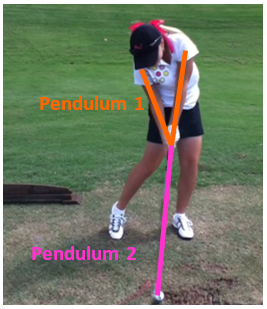
Original photograph by the author
A pendulum, a weight hung from a fixed point that freely swings under the influence of gravity, can be found in two parts of the golf swing, hence the name double pendulum effect. A golfer’s arms pivoting around the fixed point of his shoulders represent the first pendulum. The wrists are the pivot point for the golf club, the second pendulum. The two pendulums can best be seen as the golfer returns the club back to the ball in the forward swing. As the golfer begins the forward swing, the arms first pivot around the shoulders, then the club simultaneously pivots around the wrists as the golfer’s arms and club line up vertically to hit the golf ball.
Centripetal Force
For all objects in circular motion, the net force (the centripetal force) is in the same direction as the acceleration which is toward the center of the circle. The motion of a golf swing can be thought of as a large circle with the lower body anchored as the wrists pull inward and the golf club swings outward. The further the end of the golf club is from the center of rotation (the golfer), the more speed is created. This effect can be seen in the relationship between angular and translational velocity: v = r ω where v is translational velocity, r is the radius of the circle, and ω is the angular velocity. Translational velocity and the radius share a direct relationship which means an increase in the radius will result in an increase in translational velocity. Put in a golf context, the translational velocity of the golf club head and the slower angular velocity of the golfer’s wrists create tension in the golf club. The force of tension minus a weight component of the golf club represents the centripetal force of the golf swing. An increase in distance from the center of rotation also results in an increase in centripetal force (FC = mω2r).
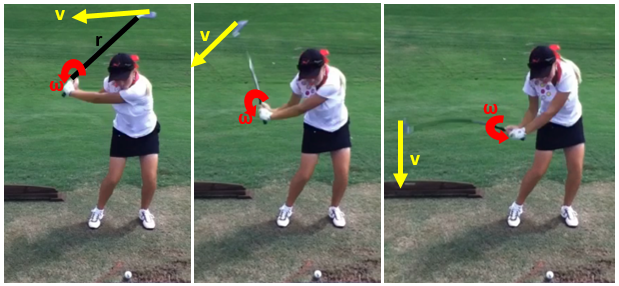
Original photograph by the author
Torque
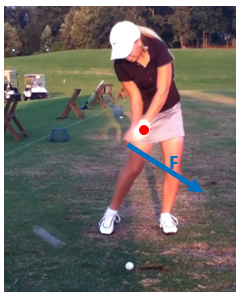
Original photograph by the author
Torque, which measures how much a force causes an object to rotate, may be the most integral part of the golf swing. There are two main areas of torque in a golf swing: wrist torque and shoulder torque. Represented as force times radius, a force applied by the hands on the golf club creates torque as the club is released down to the golf ball. More specifically, for a right-handed golfer in the forward swing, the right hand pushes (force) on the grip of the golf club as the left hand works against that motion (pivot); the distance between the right and left hands is the radius. As the right hand applies force on the club in attempt to release the club head, positive torque is created. Similarly, the force of the wrists in the forward swing in opposition to the pivot point of the shoulders creates shoulder torque.
While several other physics concepts govern the motions of the golf swing, the double pendulum effect, centripetal force, and torque are essential to mastering the swing. Though I have used these ideas throughout my golfing history, it is helpful to back it with scientific explanations rather than trial-and-error. Any change in the mechanics of a golf swing could be the difference between hitting the ball on the putting green versus hitting it in the water. It is a common saying among golfers that golf is a mental game…well, I think it is also a game of physics.
Works Cited
Gwynne, P. (2015, December 09). In Search Of The Perfect Golf Swing. Retrieved May 11, 2016, from https://www.insidescience.org/content/search-perfect-golf-swing/3471
Mgrdichian, L. (2006, December 18). Physics Reveals the Key to a Great Golf Swing. Retrieved May 11, 2016, from http://phys.org/news/2006-12-physics-reveals-key-great-golf.html
USGA (Producer). (2014, May). Science of Golf [Video file]. Retrieved May 12, 2016, from http://www.nbclearn.com/science-of-golf/cuecard/64728
White, R. (2008, December). Golf Swing Physics. Retrieved May 11, 2016, from http://www.tutelman.com/golf/swing/golfSwingPhysics3a.php#wristtorque
Quantized Magazine. All Right Reserved.

-
An original poem by Houston McClurkan, AP Physics 1 student
Featured image is an original photograph by the author
Original photography by the author
Gravity
A relentless force,
You bind us together,
We cannot find you because you are not visible,
But we can capture you in many earthly visuals,Where did you come from we will never know,
Your strength and power cause rivers to flow,Though we cannot see you we know you’ll come through,
Your relentless force will always reign true,The night sky seems still,
We know that’s not real,
You cause the stars in the sky,
To appear as if they fall like a hill.Gravity,
A relentless force,
Causing the orbit of our earthy orb.Quantized Magazine. All Rights Reserved.

-
by Rebecca Guerreso, AP Physics 1 Student
Ludwig van Beethoven once proclaimed, “Music is … A higher revelation than all Wisdom & Philosophy.” Music plays an important role in many people’s lives, yet few know that the basis of music and its sound derive from the laws of physics. Upon hearing a stirring piano solo, one may wonder what is occurring inside the piano that results in such a beautiful sound; the mysteries of sound within a piano originate from basic physics principles. Physics phenomenon regarding waves and oscillations result in the piano creating music.
Understanding the cause of the diverse sounds a piano produces, requires knowledge of the different parts inside the instrument. When a key is pressed on the piano, a sound is heard; when the key is pressed with a larger amount of force, the sound becomes louder. This sound and its amplitude are caused by four major components of the piano: the hammer, the damper, strings, and the soundboard. Every key has a damper, hammer, and either one, two, or three strings. Each of these parts has a different function; the damper stops the string from vibrating to ensure that when a key is pressed, only that key makes a sound. The hammer strikes the string, resulting in vibrations. The soundboard amplifies the string’s vibrations to make the sound louder. When a key is pressed, the damper is released so that the string can make a sound, the hammer strikes the string, and the string vibrates to make a sound.
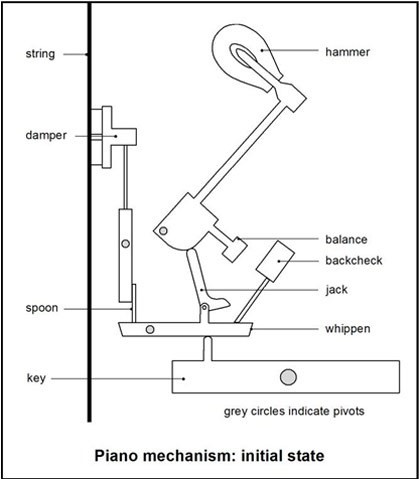
Photo credit: https://mrlarsennsms.wordpress.com/the-piano/
A typical piano contains eighty-eight keys and has a range of seven different octaves. Starting from the right side of the piano, the first key has the highest pitch, and the pitch of each key after it decreases. The properties of the string for each key determine the pitch that the key will produce. Physics principles have determined that a longer string results in a lower pitch because the fundamental frequency is equal to the quotient of the velocity and two times the length, f = v/(2L). Inside the piano, the strings increase in length for keys with lower pitches, but if only the length were changed for each string, then the strings would exceed the height of the piano. Therefore, to lower a pitch of a key, the length is increased along with the diameter of the string. This concept holds true for all keys to the right of middle C; the keys to the left of middle C must be adjusted differently. If the diameter and length continued to increase, the string would not be able to vibrate regularly after a certain point, which would result in the production of an irregular sound. The keys to the left of middle C have a very low pitch; to accommodate this low pitch, the normal steel wires are wound with a copper wire. By winding the strings together, the total mass of the string increases, allowing the string to vibrate properly because if the mass is increased then the frequency of the string decreases. These physics principles result in octaves on musical instruments; physics has proven that doubling the length of the string decreases the resulting sound by an octave.

Photo credit: http://www.piano-keyboard-guide.com/wp-content/uploads/2015/09/88-key-piano-keyboard-layout.jpg
Typically, the frequency of each string on a piano ranges from sixteen hertz to seven thousand and nine hundred hertz, while wavelength varies from four centimeters to two thousand and one hundred centimeters. The ranges in frequencies and wavelengths cause each key to produce a different sound. A piano contains seven octaves and these seven octaves repeat throughout the eighty-eight keys on the piano (first key on far left is A; last key on far right is C). Each note on the piano has a fundamental frequency; to increase the note by one octave, the fundamental frequency must be doubled; to increase the note by two octaves, the fundamental frequency must be quadrupled (or the first level frequency must be doubled). The changed frequency creates different tones for each note.
Another factor that affects the piano’s sound are the three pedals. On a standard upright piano, the pedal farthest to the right is called the damper pedal, and is the most commonly used pedal. This pedal allows the notes to be played much more smoothly. When the damper pedal is pressed, the dampers are released from the strings. Consequently, when a note is played all the strings vibrate since there are no dampers to inhibit vibrations. The celeste pedal is the middle pedal; it drops a felt pad onto the tops of the strings in order to lower the amount of vibrations on the string, and in effect, make the sound much quieter. The pedal to the far left is the una corda pedal; it shifts the hammers so that it strikes fewer strings than usual, creating a softer sound because there are less vibrations.
The piano and the sounds it produces utilize many physics principles. The strings within the piano operate at different frequencies, which result in different wavelengths; this is why the piano has the ability to produce such a vast range of notes. Pianos go “out of tune,” meaning the keys produce incorrect sounds, throughout the year because the temperature fluctuates, which slightly changes the speed of sound in air. The sounds the piano creates is a language that everybody in the world can understand—sounds created by manipulating laws of physics. Henry Wadsworth Longfellow once marveled, “Music is the universal language of mankind,”and I could add physics makes music possible.
Works Cited
Joyner, Lauren, Erika Littman, Emily Massey, and Johanna Robertson. “Piano Physics.” String Vibration. N.p., 2009. Web. 09 May 2016.
Rack, C. Mckinney And Nsf. “Physics of the Piano.” Physics of the Piano N Giordano — Purdue University (n.d.): n. pag. Web. 9 May 2016.
Suits, B. H. “Frequencies of Musical Notes, A4 = 440 Hz.” Frequencies of Musical Notes, A4 = 440 Hz. Michigan Technolgical University, 1998. Web. 09 May 2016.
Quantized Magazine. All Rights Reserved.

-
by Kate Williams AP Physics 1 Student

Photo credit: https://www.flickr.com/photos/johnandketurah/3155589824
Most Americans who have the ability to hear cannot fathom the lifestyle changes that come with deafness or profound hearing loss. In the United States, twelve thousand babies are born partially or completely deaf every year. Conservative ways to support deafness are Sign Language, mouth reading, or just living life in complete silence. However, throughout the past few years, physics has allowed cochlear implants to become the first medical device used to replace a human sense.
Although cochlear implants have not been around for a very long time, physicists have been trying to invent a hearing device since the early 1800s. Physicist Alessandro Volta conducted an experiment in which he connected a battery to electrodes in his ear. Through this experiment, Volta heard “unpleasant noises” and started the phenomenon of artificial hearing. The first surgically implanted cochlea was designed by Williams House and passed by the Food and Drug Administration in 1984.

Photo credit: http://www.physicsclassroom.com/Class/waves/u10l1a1.gif
To fully understand the brain’s reaction to sound, scientists use physics and the study of sound waves. There are two different types of waves: longitudinal and transverse. Transverse waves move perpendicularly to the direction of motion (as shown in the bottom part of the diagram). Longitudinal waves are the opposite; their waves move parallel with the direction of motion (as shown in the top portion of the diagram). Before creating the cochlear implant, physicists had to fully understand that sound is a longitudinal wave. Mechanical longitudinal waves must have a medium in which to travel. This characteristic of longitudinal waves is an important principle of the implant that allows sound to always go through the skin and into the device.

Photo credit: http://kidshealth.org/en/parents/cochlear.html
A cochlear implant is very different from a hearing aid. Hearing aids simply use vibrations to reach the remaining hair follicles in the cochlea. However, profoundly deaf people may not have much, if any, hairs left in the cochlea which is why the cochlear implant is surgically placed and is constructed of an inner and outer part. The inner part of the implant has a small soft wire that is placed within the ear and wrapped around the inside of the cochlea. The outer part of the implant is constructed of a microphone and a speech processor. The processor must be with the user at all times for the device to work; although, it may be taken off to shower or sleep. This processor is important because it picks up the nearby noises and converts them using a transmitter that is attached to a magnet that connects the internal and external parts of the device. The transmitter sends the signals to the internal part of the implant and then on to the brain.
Even though this discovery has helped thousands of deaf people, it does not come without risks. One major risk of the surgery is that it just may not work. The human ear is a very sensitive area and sometimes the surgery is not successful for certain people. A common misconception about cochlear implants is that the effect on hearing is immediate; however, six weeks are required for the surgical site to heal and be ready for the external portion of the implant. When the audiologist first attaches the outer piece, the recipient may not hear anything at first. It is the doctor’s job to then adjust the frequency of the implant until sound is heard. Once sound is heard, deaf people do not automatically understand what they are hearing. Most of the recipients have spent the majority of their lives using Sign Language and staying completely mute to outside sounds. So, although they hear sounds, the recipient must then go through long months of speech therapy to learn how to speak and understand spoken words. Many deaf adults who get the implant end up never wearing it because their brain has gotten so used to hearing no sounds that tiny noises such as the sound of a dishwasher or the starting of a car cause them a great disturbance. There is also the concern in the deaf community that cochlear implants are taking away the use of Sign Language and a culture that has been around for a very long time. In the deaf community, the appropriateness of cochlear implants is still a controversial issue, but in the physics community, it is a discovery worth sharing.
Works Cited
Cochlear Implant. Digital image. Kids Health. Nemours, n.d. Web. 20 Apr. 2016.
“Cochlear Implants.” Cochlear Implants. NIH Publications, 18 Aug. 2014. Web. 19 Apr. 2016.
“How It Works.” Hearing with a Cochlear Implant. N.p., n.d. Web. 22 Apr. 2016.
Quantized Magazine. All Right Reserved.

-
by Ashley Hazel AP Physics 1 Student

Photo credit: https://upload.wikimedia.org/wikipedia/commons/6/6e/Skydiver_on_back_of_partner_and_giving_thumbs_up.jpg
Every one has heard of the extreme sport of skydiving, yet does everyone know the physics involved with it? Physics plays a monumental role in every aspect of our lives, and for this intense hobby, physics dishes up a major dose. So let’s break things down.
The first jump.
Once you leave that plane, your heart is racing, your palms are sweating, and probably the only thing on your mind is “Ahh!.” But, have you ever stopped to think about what’s going on around you as you joyfully plummet towards the ground? As you are capturing those Instagram-worthy Go-Pro selfies, there are two forces acting on you: gravitational pull and friction with the air. As you leave the plane, Earth’s gravitational pull will carry you straight towards the ground, and you’ll gain speed with each second. While you begin to travel, the resistance from the air around you begins to increase and pushes up in the opposite direction of your fall (luckily it’s not as strong as gravity). Thanks to the relationship between gravity and air resistance, you won’t keep falling at a rapidly increasing speed, but as your speed increases, so does air resistance. The air resistance will keep increasing until it reaches the magnitude of the force of gravity. Once this happens, the forces become balanced, and you’ll no longer accelerate.
Body Position
Ever heard of the term aerodynamics? Well, it plays a major role in skydiving, as well. The position and shape of your body dictate your speed as you fall. For example, say you and your friend decided to race down. You go with the method of tucking your arms and legs in as tight as you can into your body. Your friend, on the other hand, decides to go full flying squirrel. You’ll notice that as you fall, like the graceful armadillo you embodied, your friend will lag behind you because of the difference in body positions. Your stretched-out friend has more surface area than you do. Air resistance has a greater surface to work on, thus slowing the body down. However, while you might be the speedy one of the group, stretching out while falling is actually a better skydiving technique because this position creates dynamic stability – keeping you more stable as you descend.
The Parachute

Photo credit: https://pixabay.com/static/uploads/photo/2014/01/21/17/37/parachute-249241_960_720.jpg
Now comes the moment of truth: the parachute. This simple little device holds the most important job of all-SLOWING YOU DOWN. But how? The answer is simple, air resistance. Just as your body position controlled your speed, the parachute’s broad surface area works to keep you from regretting your spontaneous skydiving adventure. The parachute’s huge size proves vital and is the sole reason you can significantly slow down to a speed that promises safety. This significant change in speed is why you always see the huge snap up once the parachute has been released. The huge amount of air being trapped by the parachute causes a dramatic slowdown.
Skydiving is no joke and neither is the physics involved with it. These forces that so many of us remain unaware of are responsible for so many great things in the world. Physics allows us to jump out of planes safely. I mean what else can do that, right?!? So maybe if you ever work up the nerve to go skydiving you can stop and think about what’s really going on around you. Maybe even share it with your diving instructor. Your extensive and intriguing knowledge might even make up for that full face of hair you gave him during the jump.
Sources:
http://www.physlink.com/Education/AskExperts/ae536.cfm
http://www.physicsclassroom.com/mmedia/newtlaws/sd.cfm
Quantized Magazine. All rights reserved.

-
by Paige Harriss AP Physics 1 student
“A civilized man…can go up against gravitation in a balloon, and why should he not hope that ultimately he may be able to stop or accelerate his drift along the Time-Dimension, or even turn about and travel the other way?” H.G. Wells encapsulated popular interest in time travel through this quote and others in his novel The Time Machine written in 1895. Believed to be the first novel written about time travel, The Time Machine has been in print continuously since its initial publication and reveals our national intrigue in this extraordinary concept. More recently, time travel has been studied by physicists as a plausible theory – one that may or may not be within the bounds of modern physics. Albert Einstein, Nathan Rosen, and later Kip Thorne contributed to the idea of a black hole providing a portal to the past. Other recent theories also support the idea of time travel; however, an opposing viewpoint based on the grandfather paradox refutes the notion entirely.
The theory of a black hole providing a mode of time travel has long been suggested. Black holes have the ability to bend the space and time surrounding them to the point of breaking, creating a small rip. In 1935 Nathan Rosen and Albert Einstein theorized that this small rip could connect to a rip in another black hole, creating a bridge; the Einstein-Rosen bridge, that would provide a passage through which a time traveler could be transported into another dimension. However, there are disparages with the bridge. Too small for even an atom to fit through, these “wormholes” are unusable for a time traveler, and close so quickly even light would not have the ability to pass through to the other side. In the 1980s, Kip Thorne elaborated on the Einstein-Rosen bridge and theorized a way to use anti-gravity to hold the portal open long enough for a person to pass through. Anti-gravity, pushing apart the space around the wormhole, would be channeled in large amounts to hold the portal open. To supply these large reserves of anti-gravity energy, Thorne hypothesized the Casimir effect; that two metal plates in close proximity could eventually generate enough negative energy to hold open the portal. Lastly, to create a true time portal, Thorne theorized a way to desynchronize the two black holes so that time would run differently in each. By containing one of the holes in negative energy and somehow transporting it around the universe at the speed of light, the two holes would desynchronize, with one black hole existing in a different era than the other, but in the same location. True time travel would thus be achieved. Although one of the first extensive approaches toward time travel put forth, this elaborate theory has been doubted by some physicists.
Numerous alternative approaches have permeated modern time travelling physics research. In 1991 Princeton astrophysicist J. Richard Gott proposed the idea of a shoestring. These cosmic strings, formed since close to the beginning of the universe, would pass each other in anti-parallel directions, running at the speed of light. A time traveler would thus be able to wait nearby and enter in between these strings which have twisted space-time due to their infinitely long and incredibly dense structure. Edward Witten is at present developing his super-string theory, while Stephen Hawking has even proposed lining up infinite parallel universes to achieve time travel. It seems that even if such theories prove viable, the mathematics behind each is nearly impossible to solve. Physicist Michio Kaku, commenting on the superstring theory, stated, “At present, superstring theory is the leading candidate for such a theory (in fact, it is the only candidate; it really has no rivals at all). But superstring theory…is still too difficult to solve completely. The theory is well-defined, but no one on earth is smart enough to solve it.” Theories abound, and deeply committed physicists are convinced that eventually the mystery will be solved, though perhaps, not in their lifetime. There are also those who reject all propositions of time travel, doubting the possibility that even a future generation might find the key to a parallel universe.
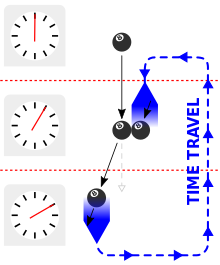
Photo credit: https://en.wikipedia.org/wiki/Causal_loop
The Grandfather Paradox presents an argument silencing any notion of time travel. Described as early as 1931 in various science fiction novels including Ancestral Voices by Nathaniel Schachner, published in 1933, and Future Times Three by René Barjavel in 1943, this paradox seems irreconcilable with the notion of travelling through time. The Grandfather Paradox presents the idea that if a person were able to travel to the past and then kill his/her parents, then that person would never have been born and thus it would be impossible to travel back in time in the first place. There have been responses to this paradox, such as the idea that the individual “would fail for some commonplace reason…her gun might jam, a noise might distract her, she might slip on a banana peel…” or that travelling in the past “merely creates a parallel universe.” So we are changing someone else’s past by saving, perhaps, Abraham Lincoln from being assassinated at the Ford Theater, but our Lincoln is still dead. A concrete answer to this fundamental complexity still has not been established. Clearly, modern mathematics must be more advanced before we are able to answer such paradoxes, or the disparagement between quantum mechanics and gravitational relativity; the fact that they “dominate in disparate domains, and…seem to converge only in enormously dense, quantum-size black holes,” must be resolved.
Even with the abundance of theories including the Einstein-Rosen bridge and superstring theory, numerous paradoxes still remain unanswered. The Grandfather Paradox will continue to discourage many from the seemingly irrational research of time travel, and, even in the event that time travel becomes possible, many will question the morality of attempting to change events of the past. However, current research on the topic has become more plausible, and it is clear that “our heirs, whatever or whoever they may be, will explore space and time to degrees we cannot currently fathom…creating new melodies in the music of time.”
Works Cited
Kaku, Michio. “The Physics of Time Travel.” Explorations in Science Official Website of Dr Michio Kaku RSS. N.p., n.d. Web. 17 Apr. 2016.
Koks, Don. “What Is the Casimir Effect?” The Casimir Effect. N.p., 2002. Web. 17 Apr. 2016.
Moyer, Michael. “The Physics of Time Travel.” Popular Science. Bonnier Corporation, 19 Feb. 2002. Web. 17 Apr. 2016.
Person, and Annalee Newitz. “Are We about to Reconcile Gravity with Quantum Mechanics?” Io9. I09, 07 Nov. 2013. Web. 17 Apr. 2016.
Pickover, Clifford. “Traveling Through Time.” PBS. PBS, 12 Oct. 1999. Web. 17 Apr. 2016.
Smith, Nicholas J.J. “Time Travel.” Stanford University. Stanford University, 14 Nov. 2013. Web. 17 Apr. 2016.
Quantized Magazine. All rights reserved.

-

Original artwork by the author
by Bree Gerold, AP Physics 1 Student
Perhaps it is the oh so exciting thought of spring break quickly approaching, or maybe it is my constant fascination with the ocean, but recently I have found myself in a daydream about the beach. Ever since I was a little girl, I have always been fascinated by the rising and the falling of the ocean waves. I remember that it always baffled me how the ocean could get bigger, then shrink back up again, like clockwork. I didn’t understand it. I didn’t understand gravity, I didn’t understand physics. Perhaps there is a bit of magic to that; to the complete innocence of a child who is so easily mesmerized by something as simple as the ocean’s tides. That’s what it was to me. It was magic.
Now as a senior in high school, I have been through many physics classes and have managed to gain at least enough knowledge to understand how the moon and the ocean create the tides. Ocean tides are created by combining the gravitational pull of the moon and the sun, combined with the rotation of the earth. The moon’s gravitational pull is stronger than the sun’s which makes it the most important factor in creating tides. The tides are really long-period waves that appear as the rise and fall of the sea as they reach the coastline. High tide is the crest of the long-period wave and low tide is the trough of the long-period wave. The earth rotates on its axis once every 24 hours and the moon rotates around the earth once every 28 days. The moon pulls upward on the ocean while the earth pulls down. This causes tidal movement. The tidal troughs are separated by about 12 hours. Because the moon rotates around the earth, it’s not in the same place at the same time every day. So the high and low tide times change every day by about 50 minutes.
Even now, after understanding the physics of it all, it still seems like magic. It is magical how the moon, that is so far away, can have such a compelling effect on the little girl I once was.
Works Cited
“Ten Cool Facts About Ocean Tides.” Oceans52. WordPress, 05 Apr. 2012. Web. 06 Mar. 2016.
Quantized Magazine. All Rights Reserved.

-
by Sarah McPherson, AP Physics 1
When looking at a dancer, the eye sees impressive movement. Behind every performance are hours of practice, sweat, and dedication. After it’s all broken down, one can find the clockwork in dancing – physics.
A major factor in dancing is balance. Dancers have to focus on their centers of gravity when performing, for if they lean too far forward, their center of mass could go beyond the base of support, and they could fall. Balancing is even more difficult if there are partners dancing together; however, dancers can use physics to their advantage. If their centers of gravity are used correctly, the end result can be a stunning visual. For their centers of gravity to be supported, physical connection, or tension, is needed. The partners pulling on each other can help each other balance. The diagram below is a great illustration of the forces working on them.
The force of gravity is pulling them down and keeping them on the floor; likewise, the weight vectors from their centers of gravity point directly down, even though they are slightly tilted. Without the tension of their arms holding each other, both of the dancers would more than likely fall – especially the girl. Holding themselves together in this fashion creates one unit with a center of mass located somewhere between each dancer and over the base of support offered by the male dancer’s feet.
Physics also applies to swing dancing. This partner dance requires focus and momentum. For example, a very famous move in swing dancing is called “The 6 O’clock.” The female partner is directly above the male partner with her arms wrapped around his neck. The female is representative of the hour hand while her counterpart is the minute hand.

Photo credit: http://www.coalcountry.org/images/killerdillers/
In order to reach this position, the female has to get a running start to reach the male, and then jump high enough for him to catch her. The woman’s kinetic energy during running is converted to gravitational potential energy with the assistance of the man performing work to lift the woman higher.
Though it may seem unlikely, physics is a key part of dancing. Without this science, the dancers wouldn’t be able achieve certain movements and the dance would be dull. Physics brings excitement to the dance!
Reference: http://www.hep.uiuc.edu/home/g-gollin/dance/dance_physics.html.
About the author: Sarah McPherson is a student in AP Physics 1 and is also the Drum Major for the Marching Grizzlies. In addition, she is the artist of the featured image in the page header.
Quantized Magazine. All Rights Reserved.

-

Carden with his model “G Money.”
AP Physics 1 students were challenged to create a diagram and model of an original roller coaster design. The challenge required the students’ designs to exhibit realistic g forces, velocities, heights, and inclines. Students applied concepts of circular motion dynamics and energy conservation to calculate and label the velocity, centripetal acceleration, and g’s for at least three locations on the design. They also calculated and labeled the required energy to start the roller coaster. The project required the roller coasters to have at least one hill and one loop, and maximum g’s were required to be less than 6 to maintain rider safety.
The creation of a model:

Kendra and Leslie with their model of “No Clue.”
Quantized Magazine. All Rights Reserved.

-
by Leslie Medina, AP Physics 1 student

Painting by Leslie Medina
When I think of Mother Earth, I imagine hearing a pulse, and I visualize all the natural beauty that Earth contains. When I give such human-like qualities to Earth, I envision her breathing, even though I know this is not how things work. I think about all the possibilities and opportunities that Earth has given us. The ability to live, explore, and gain knowledge about our universe and the galaxies that endlessly fascinate us. When I depicted Earth breathing and exhaling, I was visualizing how Earth metaphorically takes in knowledge of its surroundings.
With this knowledge, there is an even greater desire to learn more about Earth, space, and life itself. Physics explores many things concerning these expansive topics and attempts to offer an explanation of all the extraordinary phenomena that surround us. On my painting, various equations and key details concerning gravity, orbits, and planets, appear as stars in the night sky. What I’ve come to realize is that these equations not only fill up the background space of my painting, but they also fill up the spaces in our curious minds with an abundance of knowledge.
About the author:
Leslie Medina is an Honors/AP student at Creekview High School, and she is also an amazing artist.Quantized Magazine. All Rights Reserved.

-
by Briana Purves, 6th period CP Physics
Most people consider dark matter and black holes to be mysteries; however, with the help of scientists and technology, these mysteries can be understood! Dark matter is a nonluminous material that exists in space and can appear in many different forms. Black holes are a region of space with a gravitational field so intense that no matter or radiation can escape it. Black holes also have the ability to deflect light, but dark matter does not. Overall, there are many things that we can learn about both dark matter and black holes.
Nonluminous, dark matter is postulated to exist in space and can take any of several forms, including weakly interacting particles or even high energy randomly moving particles created soon after the Big Bang. Although it is not in the form of visible stars and planets, scientists have deduced the existence of dark matter because there is not enough visible matter in the universe to account for the gravitational effects present in the universe. Research supports that dark matter makes up a substantial percentage of the matter-energy composition of the universe, while the rest is dark energy and “ordinary” visible matter. Dark matter is not in the form of dark clouds filled with normal matter, but can be seen as matter made by baryons particles that are composed of protons, neutrons, and electrons.
Dark matter was originally known as the “missing mass” until Fritz Zwicky discovered that the mass of all the stars in the Coma Cluster of galaxies provided about one percent of the mass required to keep the galaxies from escaping the cluster’s gravitational pull. Missing mass remained a question until the 1970s when two American astronomers proved its existence through the idea that the mass of the galaxy within the orbit of stars must increase linearly with the distance of stars from the galaxy’s center. Also, dark matter is not capable of being composed of antimatter, because scientists would be able to see gamma rays that have been produced when antimatter annihilates with matter. Scientists are still unsure of the exact composition of dark matter, but the most common view is that dark matter is made up of exotic particles called axions, or weakly interacting massive particles.
Conversely, black holes are a region of space that has a gravitational field so intense that no matter or radiation can escape it. The gravity of a black hole is so strong because the matter has been squeezed into the tiny space, not allowing it to escape. People cannot see black holes, as they are invisible to the human eye, and can only be detected by advanced special telescopes. Black holes come in many different sizes and shapes, from the size of a large planet to as small as just one atom. Even the extremely small black holes contain massive amounts of matter inside.

Photo credit: http://image.slidesharecdn.com/blackholes2
One type of black hole that has been discovered is called a Stellar. Stellars can grow to be up to twenty times as big as the mass of the sun; however, there are black holes that can grow to be even bigger; these black holes are called Supermassives. Supermasssives can have masses up to one million times greater than the sun’s mass. Scientists have found that these Supermassive black holes are most commonly found in the Milky Way (also known as Sagittarius A) and have a mass equal to four-million suns and a few million earths.
Black holes are formed when the center of a star falls in on itself causing a supernova or when an exploding star blasts parts into space. Many black holes cannot be seen today because of the strong gravitational pull of light into the center of the hole. When a black hole and a star are near each other, high energy light is made that can only be seen by satellites and telescopes in space.
Einstein’s Law of General Relativity explains why black holes deflect light. Einstein’s law states that a ray of light arriving from one side of an object is bent inwards so that its apparent direction of origin, when viewed from the opposite side, is seen as a different angle. The observed gravitational effect between masses will result from their warping of space-time. Einstein’s Law of General Relativity predicts that every object’s gravitational field bends light rays which is called gravitational lensing. According to Wikipedia, “A gravitational lens is a distribution of matter between a distant source and an observer, that is capable of bending the light from the source, as it travels towards the observer.” Einstein’s Law of General Relativity also supports that the gravitational fields of massive objects causes a distortion in space-time. Einstein’s Law of General Relativity proves just how black holes have the capability to deflect light, as they are able to bend light rays through its gravity.
People have the capability of learning infinite things about both dark matter and black holes. Such things can include how dark matter is known as a nonluminous material that is postulated to exist in space and that can take any of several forms, while, contrarily, black holes are known as a region of space that has a gravitational field so intense that no matter or radiation can escape. Black holes also have the capability to deflect light, which can be proven by Einstein’s Law of General Relativity and through gravitational lensing. If all of these things can be learned about dark matter and black holes through the writing of this one essay, imagine what can be learned throughout a lifetime.
About the author:

Briana Purves is not only an excellent physics student, she is an outstanding softball player.Quantized Magazine. All Rights Reserved.

-
-
Thank you to Ted-Ed for this lesson on the dual nature of light. “One of the most amazing facts in physics is that everything in the universe, from light to electrons to atoms, behaves like both a particle and a … Continue reading →

-

Photo credit: https://d1guvqt7k9h5xe.cloudfront.net/AcuCustom/ Sitename/DAM/005/red_400x400.jpg
by Emily Lehman and Meghan Nay
We are avid Angry Birds fans, so when our physics teacher offered us the opportunity to analyze the validity of physics principles underlying the game, we accepted eagerly. We conducted an analysis to determine whether the mobile application “Angry Birds†followed the principles of physics – specifically, principles of projectile motion.
We videoed the game from the initial launch of a bird to his collision with the pig pedestal. Then, we used Tracker software to collect data of the bird’s motion. Here’s our procedure:
1) We uploaded the video of the red angry bird into the software,Tracker.
2) Using Tracker, we found the horizontal and vertical position vs. time graphs. From there, we found the equation of the best fit line/curve.
3) After obtaining the equation of best fit for the position vs. time data, we took the derivative in order to find the velocity vs. time equation.
4) Then to find the acceleration vs. time equation, we took the derivative of the velocity vs. time equation.
5) Using the position, velocity, and acceleration equations, we were then able to analyze the bird’s motion and compare it to the laws of projectile motion on Earth.
6) Since we don’t know any of the measurements in the video, we established an arbitrary unit of length using the pig pedestal in the video. All equations are based on a unit of length we have called a “pig pedestal.”
Data and Analysis:
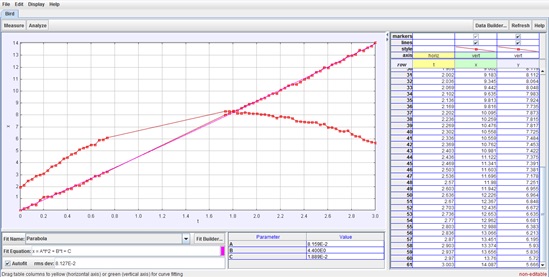
Position vs. time data using Tracker. The straight line is the horizontal position vs. time, and the concave-down parabola is the vertical position vs. time.
The graph above shows the position of the bird in the x and y directions. The best fit line for the graph in the y direction is the equation y = -1.882t² + 6.833t + 1.993. To find the velocity of this position graph we took the derivative and found the equation of the velocity in the y direction to be v = -3.764t + 6.833. Also, to find the acceleration in the y direction we found the derivative of the velocity equation and found the acceleration in the y direction to be a=-3.764 pig pedestals/s².
We repeated these steps to find the equations of the position, velocity, and acceleration graphs in the x direction. Which in subsequent order the equations of these graphs are x = 4.637t – 0.0668, v =4.637 pig pedestals/s, and a = 0 pig pedestals/s².
X-Direction
Position vs Time: s(t) = 4.637t – 0.0668
Velocity vs Time: s'(t) = v(t)= 4.637 pedestals/s
Acceleration vs Time: sâ€(t) = v’(t) = a(t) = 0 pedestals/s²
Y-Direction
Position vs Time: s(t) =-1.882t² + 6.833t +1.993
Velocity vs Time: s'(t) =v(t) =-3.764t + 6.833
Acceleration vs Time: sâ€(t) = v'(t) = a(t) =-3.764 pedestals/s²
We assumed that the Angry Birds game takes place on Earth where the acceleration due to gravity is -9.8 m/s². Using the vertical acceleration from the best fit line, we  set -3.764 pig pedestals/s2 equal to -9.8 meters/s2  which determined the height of the pig pedestal to be 2.603 meters.
Conclusion:
Based on our findings, we were able to determine that “Angry Birds†follows the rules of physics for a number of reasons. The acceleration of the bird in the x direction was zero, which is characteristic of an object launched as a projectile on Earth, assuming no air resistance. Also because the position vs. time graph in the y direction closely followed the kinematics position equation, we determined that the Angry Bird is subject to a gravitational force.
We also made some strange or odd discoveries about the game. Using the unit conversion discussed in the Analysis section, we found that the actual size of an Angry Bird is 1.019 meters tall, which is around 3.3 feet. We derived this number from the position vs. time graph in the y direction. We found the acceleration to be -3.764, but this was not meters/second2; the units for this was pig pedestals/second2. By assuming gravity in “Angry Birds†was -9.8, we used conversions to find the height of the pig pedestal. Then, we were able to find the height of the bird, which was 1.1019 meters. Certainly, a bird of this size would be subject to air resistance; however, the data show no force in the horizontal direction!

Photo credit: http://resources0.news.com.au/images/ 2012/09/16/1226475/242180-rheinmetall-039-s-simulators-in-use.jpg
Determining that one video game followed the rules of physics on Earth opens up many possibilities for real world applications. Virtual simulations have the potential to revolutionize society and many fields of work. For example, virtual simulations are extremely helpful in pilot training or training for warfare. The analysis that we undertook could be used to assess the validity of these simulations and thus gauge their acceptability as effective training tools.
Quantized Magazine. All rights reserved.
-
In an effort to achieve consistency with current expectations of university physics students in rigorous science and engineering programs, I have implemented laboratory investigations that seek to provide students with opportunities to explore real world motion using modern tools and techniques that are grounded in fundamental physics principles. My goal is for the students to be able to:
- Observe and video everyday motion and then analyze the video to extract motion data.
- Apply fundamental physics principles to analyze and describe the motion and then to develop computer models that explain and predict motion based on these principles.
- Effectively communicate results (the observations, the models, and comparisons between them).
- Critique their own work and the work of their peers.
My students have completed their first assignment that required that they explore the effects of air resistance by observing the motion of an object dropped from rest and allowed to fall straight down. The students were instructed to choose an object that would be noticeably affected by air resistance. The students selected objects such as coffee filters, Styrofoam lunch trays, crumpled paper, etc., and the adventure began. The students posted their final results on YouTube to allow for peer assessment of their final products.
I was very pleased and impressed with my students’ motivation and ability to meet this challenge. At first, some of them were intimated by working with computer code but quickly became comfortable with this new method of analyzing motion. Some sample student projects are provided below:
-
Originally posted on Open Matters:
An afternoon at the playground might be the perfect time to introduce kids to physics. SciPlay, part of the New York Hall of Science, is working to develop an app to teach middle school students the Newtonian mechanics of the playground. FastCoDesign reports:
The SciPlay app is essentially an annotated video: Using an iPad, you film motion–running, jumping, swinging, sliding, throwing a ball, etc.–and the app visualizes the basic science at work, pinpointing moments and levels of velocity, acceleration,Â, and force. Through manually tracing the arc of motion of the ball or person, or by using sensor data from the iPod attached to a ball or a kid’s belt, it superimposes theÂÂthat make up the backbone of any classroom physics lesson on real-life situations.According to the article, the developers plan to…
View original 12 more words
-
Old friends share tales of
cosmic adventures before
dawn breaks their respite.
Photo credit: http://www.guillaumepoulin.com/cosmos
 Quantized Magazine. All Rights Reserved. 2014
-
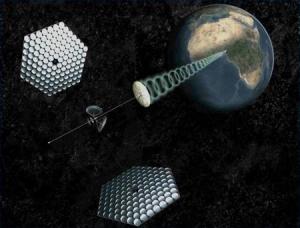
Photo credit: http://s1.reutersmedia.net/
A winning submission to the 2014 ExploraVision competition by Sarah Buelow and Henry Homiller
Solar energy is steadily increasing in popularity because it is readily available and plentiful. Individuals use solar energy to power or heat their homes, but do not generate enough electricity to make a significant impact on reducing our dependence on oil and other nonrenewable resources. If solar energy were harnessed properly, it would be possible to power the entire planet. Solar power could be harnessed more efficiently with a space-located orbital generator that allows for the removal of solar refraction and filtration that occurs in Earth’s atmosphere. Satellite systems can be designed to harness solar energy, but without proper extraction methods, the transfer of energy from space to earth is flawed, and impossible. Available technology requires the use of large and impractical rectifying antenna arrays for this task.  Our proposed design incorporates 3D meta-material lenses capable of focusing radio waves with extreme precision, thus lowering the size of the array required while increasing the transfer efficiency.
Present Technology

Photo credit: http://assets.inhabitat.com/
The proposed satellite generator takes advantage of several different existing technologies; the foremost is the photovoltaic panel. Photovoltaic or PV panels are in use already, though their fabrication makes them less practical than they could be. PV arrays are designed to capture the energy of light, particularly from the sun, and generate direct current electricity. The basic principle used is that a semiconductor, such as silicon, when bombarded by a photon, can have one of its electrons ejected, allowing it to flow from atom to atom, and generating electrical power. The semiconductor is typically doped with another element to make it P-type or N-type, based on which charge it will carry. When P-type and N-type panels are put together in an array, they acquire a built-in electric field that guides the loose electrons in one direction, generating direct current. When conductive connections are attached to the apparatus, the electrons can be pushed through an available current path by the field. Other modifications can be made, such as non-reflective coating, to maximize light absorption. The largest downside of PV arrays is that they are still expensive; however, solar power technology is one of the most rapidly growing technologies in the world (Toothman, Alduos).
The second chief technology is the receptor of the energy being transmitted to Earth. The rectifying antenna, or rectenna, has been in use for some time. A normal antenna absorbs an electromagnetic wave, typically a radio wave, and transforms its energy into electricity. The distinguishing feature of this particular antenna is that, rather than a radio antenna, which absorbs the electricity purely for information, the rectenna is attached to a rectifier which turns the AC electricity into DC, for use in charging batteries or otherwise powering mechanisms. The use of radio waves being used to send power wirelessly has been demonstrated on a small scale with relative ease, such as a remote control helicopter, and is a rapidly expanding idea (Zhang, Huang).
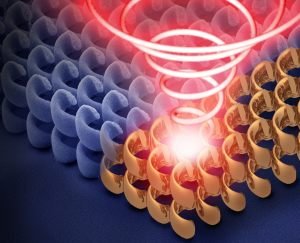
Photo credit: http://www.azonano.com/
Third, a new study in the use of meta-materials provides a way to focus electromagnetic waves using negative refraction, allowing for much more focused applications of this form of energy. Designed by researchers at MIT, a copper-plated structured dish can be 3-D printed and used to focus radio waves, defying what traditionally would be expected from the base shape, using the complex structure of the meta-material (Chu). Lastly, the present knowledge of space and orbital mechanics is necessary in order to place the satellite and maneuver it into a geosynchronous orbit, remaining above the same place on the surface.
History of Solar Energy
Solar energy has been used as far back as the times of the Ancient Greeks, Chinese, and Native Americans, although their methods were very primitive. Mainly, these peoples oriented their buildings toward the sun to warm them, not fully understanding at the time how solar energy worked. These peoples also used mirrors and other reflective surfaces to light torches and fires, and, in second century B.C. Greece, used the reflective properties of bronze shields to defend the city by setting enemy ships on fire. The first known solar-powered mechanical device was a steam engine designed by French engineer Auguste Mouchout in 1866, which began the influx in solar inventions over the next fifty years. Inventors such as John Ericsson, Charles Tellier, and Frank Shuman worked on solar energy methods with irrigation, refrigeration, and locomotives. It was not until many years later, in 1954, when researchers at Bell Laboratories developed what has become the modern edge of solar energy – the photovoltaic cell, which is capable of converting light into electricity (ScienceDaily).
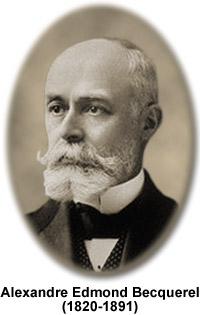
Photo credit: http://micro.magnet.fsu.edu
Of course, the photovoltaic effect was originally discovered in 1839 by French scientist Edmond Becquerel while he was experimenting with an electrolytic cell. Over the years, solar power slowly improved. Willoughby Smith discovered the photoconductivity of selenium in 1873, and three years later, William Grylls Adams and Richard Evans Day found that selenium produced electricity when exposed to light. By 1883, American inventor Charles Fritts, described the first ever solar cells made from thin strips of selenium. As time passed on, more and more people discovered or proved different methods to harness solar energy into electricity by expanding on photovoltaic devices and photoelectric effect understandings. Bell Telephone Laboratories in 1954 provided the U.S. with successful solar cells, although the efficiency of these early solar cells was a whopping four percent. Hoffman Electronics worked on improving the efficiency, going from eight percent in 1957, to nine percent in 1958, and eventually ten percent in 1959. A year later that efficiency increased by four percent bringing it up to fourteen percent. NASA also jumped on board with solar technology in 1964, with the launch of the Nimbus spacecraft – a satellite powered by a 470-watt photovoltaic ray. Efficiency and cost continued to improve, making solar cells cheaper, and more efficient as time went on. By 1977, photovoltaic manufacturing exceeded 500 kilowatts. Solar energy was added to aircraft, satellites, vehicles, and buildings, and methods for harnessing solar energy slowly improved into what it is today (U.S. Department of Energy).
Future Technology
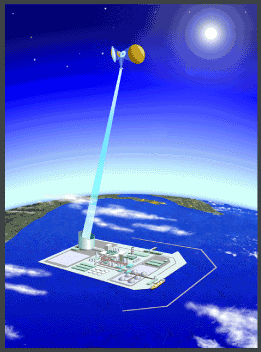
Photo credit: http://thomasfortenberry.net
Our proposition combines several existing ideas: the use of rectennas for wireless power, the use of solar energy production in orbit, and the study of meta-materials. By adding the technology behind the dish produced by MIT, we believe the idea for a wireless orbital solar generator is now reasonable, where it hasn’t been in the past. This opens up an entire new branch of power generation, which, with further development, could future proof the power industry with fully renewable methods of harvesting unused energy. The full task of the orbital generator is to translate energy from the sun into electricity on Earth. The first step is to capture the photons that make up the light coming from the sun by using conventional photovoltaic arrays, converting the energy into electric energy. This electrical energy would power a radio broadcaster, which would use the meta-material dish to create a focused wave that would travel through the atmosphere, reaching the rectenna array connected to the ground relay station. By keeping the orbital component in a geosynchronous orbit, the radio beam would constantly be focused on the rectenna, maximizing the efficiency of this final, most difficult step. The radio beam would then be transformed back into electric current and submitted to the power grid like any other power station.
Breakthroughs Required
The technology, while well on its way, is not quite at the level necessary to make the best use of an orbital solar generator. There are several fields that must be improved first. The study behind solar power is rapidly expanding already, and new, more efficient PV panels are being designed rapidly. Only a short time will need to pass before high efficiency, cheap, and lightweight arrays are available. In addition, the budding science of meta-materials has only just begun, and has no end of room to improve. Better designs than those that currently exist may allow even more precise focusing of radio waves, allowing for an improved efficiency in orbit-to-surface energy transfer, as well as smaller rectenna arrays. The more precise the focusing, the more energy can be successfully transferred, and the less area would be needed both on the ground for the receiving arrays, and in the air as required clear airspace. Along with a more precise electromagnetic broadcast, improvements in orbital control and telemetry will likely be in order. Faster, more accurate commands being sent to the satellite would keep it in the precise position overhead that would be required to be able to process the greatest amount of energy.
Consequences
The primary effect of the orbital solar generator would be, of course, generation of solar energy that would be both more efficient and more reliable. Keeping a geosynchronous orbit has the benefit of allowing greater precision and efficiency of energy transfer, but will cause the recurrence of one of the chief problems of solar panels: night time power generation would be nonexistent. However, the time period for which there would be no power would be significantly less than that of a PV array on Earth. The curvature of the Earth as well as computerized rotation and positioning of the panels would allow the satellite to absorb light for a significantly longer period each rotation. This strategy also allows for the precision in the radio wave transfer. By allotting a small area of restricted airspace, the collected energy is made much more reliable, as clouds and weather will have less detrimental effects on the production of energy. The main negative effect would be the potential interference that the radio wave beam might cause in the surrounding area. The focusing nature of the meta-material dish will lower this, but it is impossible to tell at this stage in the development of the technology to what degree the interference would remain.
The power produced over the years of operation of the satellite would make the cost of materials worthwhile, and its lifespan could be greatly increased by use of space shuttle missions for repair and possible upgrade. The new methods of energy production made available would make a step toward cutting back on fossil fuel consumption and lead in to more reliable, sustainable energy.
References
Egendorf, Laura K. Energy Alternatives. Detroit: Greenhaven, 2006. Print.
Jones, Susan. Solar Power of the Future: New Ways of Turning Sunlight into Energy. New York: Rosen Pub. Group, 2003. Print.
Toothman, Jessika, and Scott Aldous. “How Solar Cells Work.” HowStuffWorks. Discovery, n.d. Web. 11 Nov. 2013. <http://science.howstuffworks.com/environmental/energy/solar-cell.htm>.
Zhang, Jingwei, and Yi Huang. Rectennas for Wireless Energy Harvesting. Rep. University of Liverpool, n.d. Web. 2 Dec. 2013.
“Solar Power.” ScienceDaily. ScienceDaily. 19 Nov. 2013 <http://www.sciencedaily.com/articles/s/solar_power.htm>.
United States. Energy Efficiency and Renewable Energy. Department of Energy. The History of Solar. 2002. U.S. Department of Energy. 3 Dec. 2013 <http://www1.eere.energy.gov/solar/pdfs/solar_timeline.pdf>.
Chu, Jennifer. “New Metamaterial Lens Focuses Radio Waves.” MIT’s News Office. MIT, 14 Nov. 2012. Web. 03 Dec. 2013.
Quantized Magazine. All rights reserved.




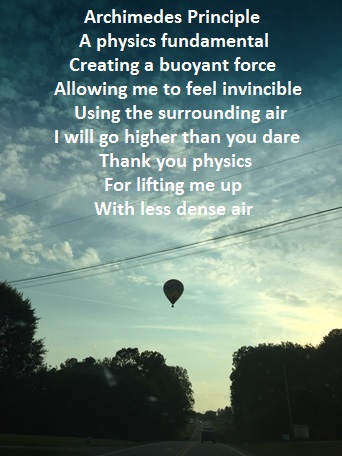





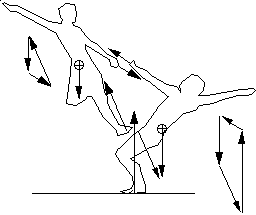




Keep America’s Nuclear Power Plants Working For US
In News Headlines
Posted
From: https://petitions.whitehouse.gov//petition/keep-americas-nuclear-power-plants-working-us
“America’s nuclear energy plants are a vital asset providing reliable, carbon-free electricity to tens of millions of households and businesses around the country. Nuclear energy plants supply nearly 20 percent of America’s electricity—and 63 percent of the nation’s carbon-free electricity.
Despite their value, a combination of factors place these plants in economic jeopardy. As a result, a half dozen of the 100 in the nation will close in the coming years to be replaced by natural gas.
Respectfully request that the federal government institute policies that recognize the special and unique benefits of nuclear power. The federal government regulates their licensing and operation, but leaves it to the individual states to determine the value of their carbon neutral electricity.”
Click here to help: https://petitions.whitehouse.gov//petition/keep-americas-nuclear-power-plants-working-us
View the full article